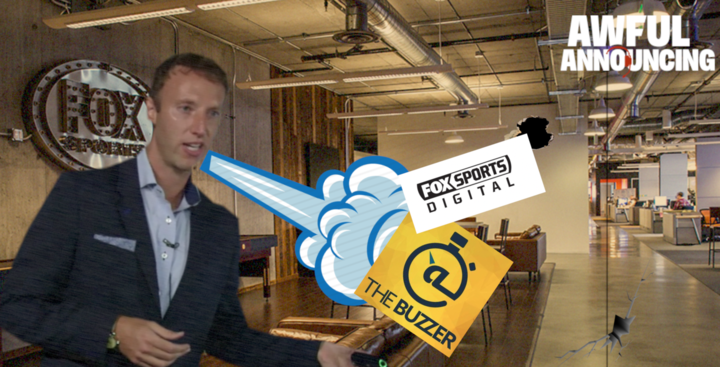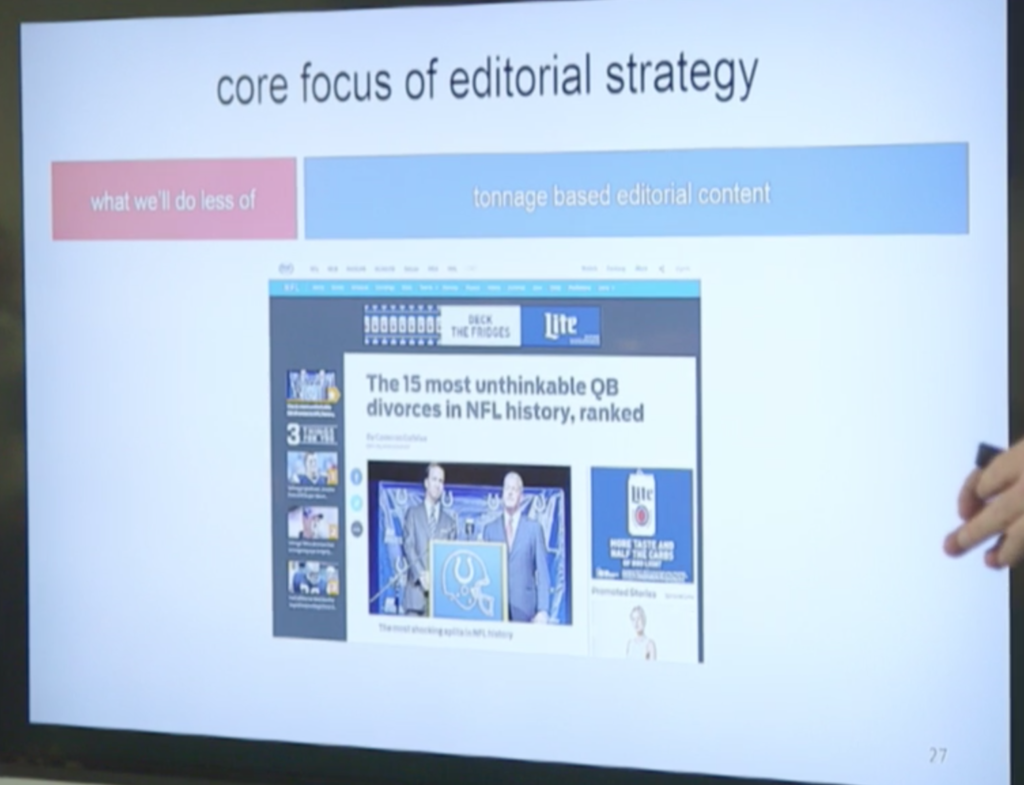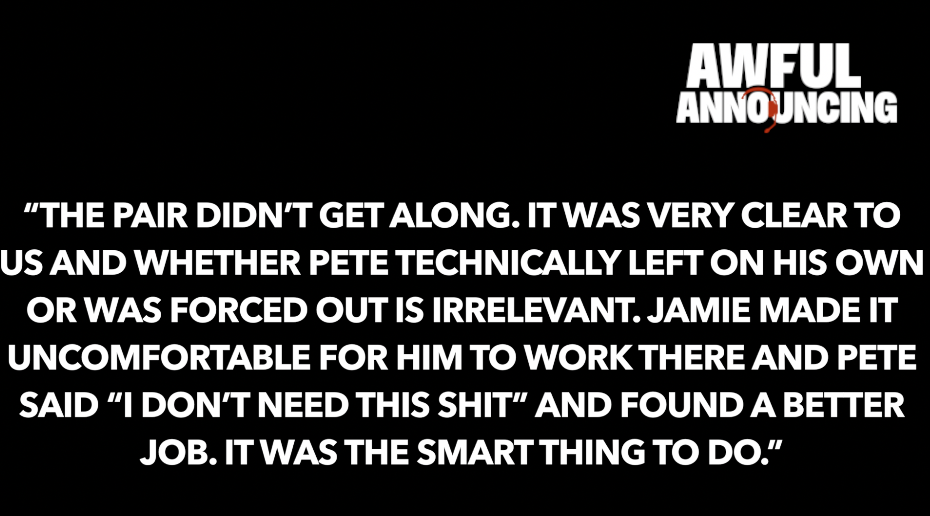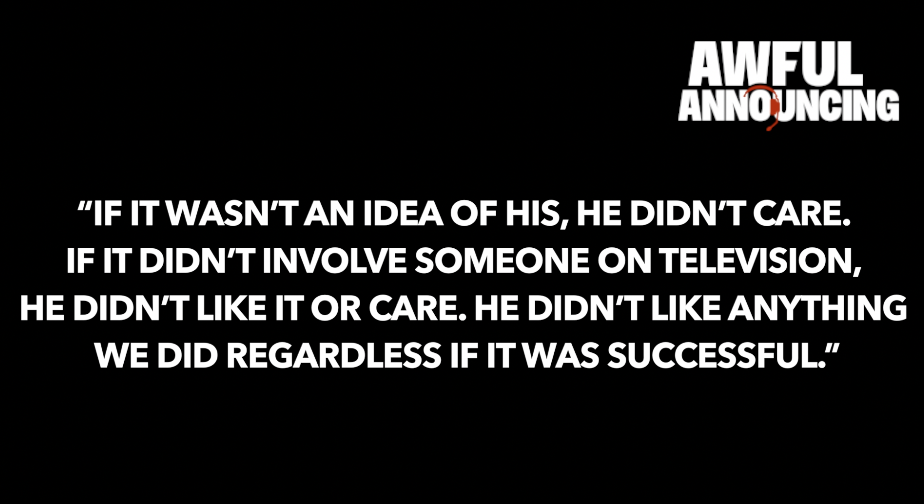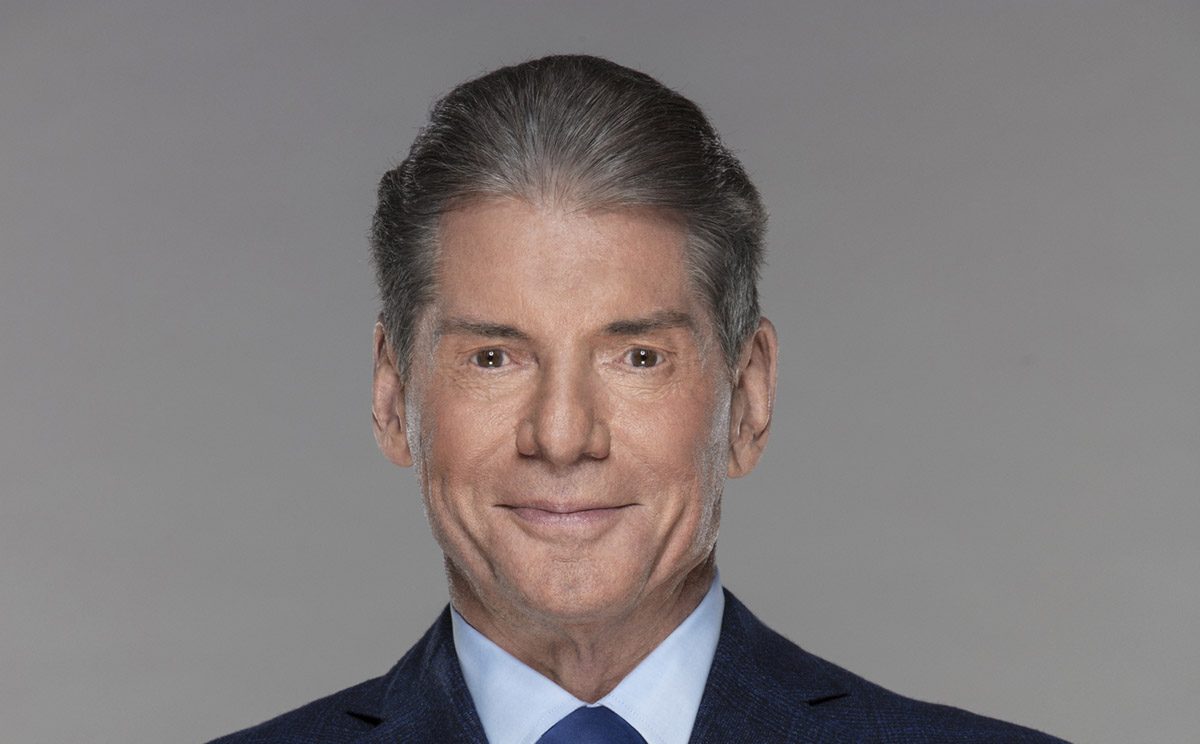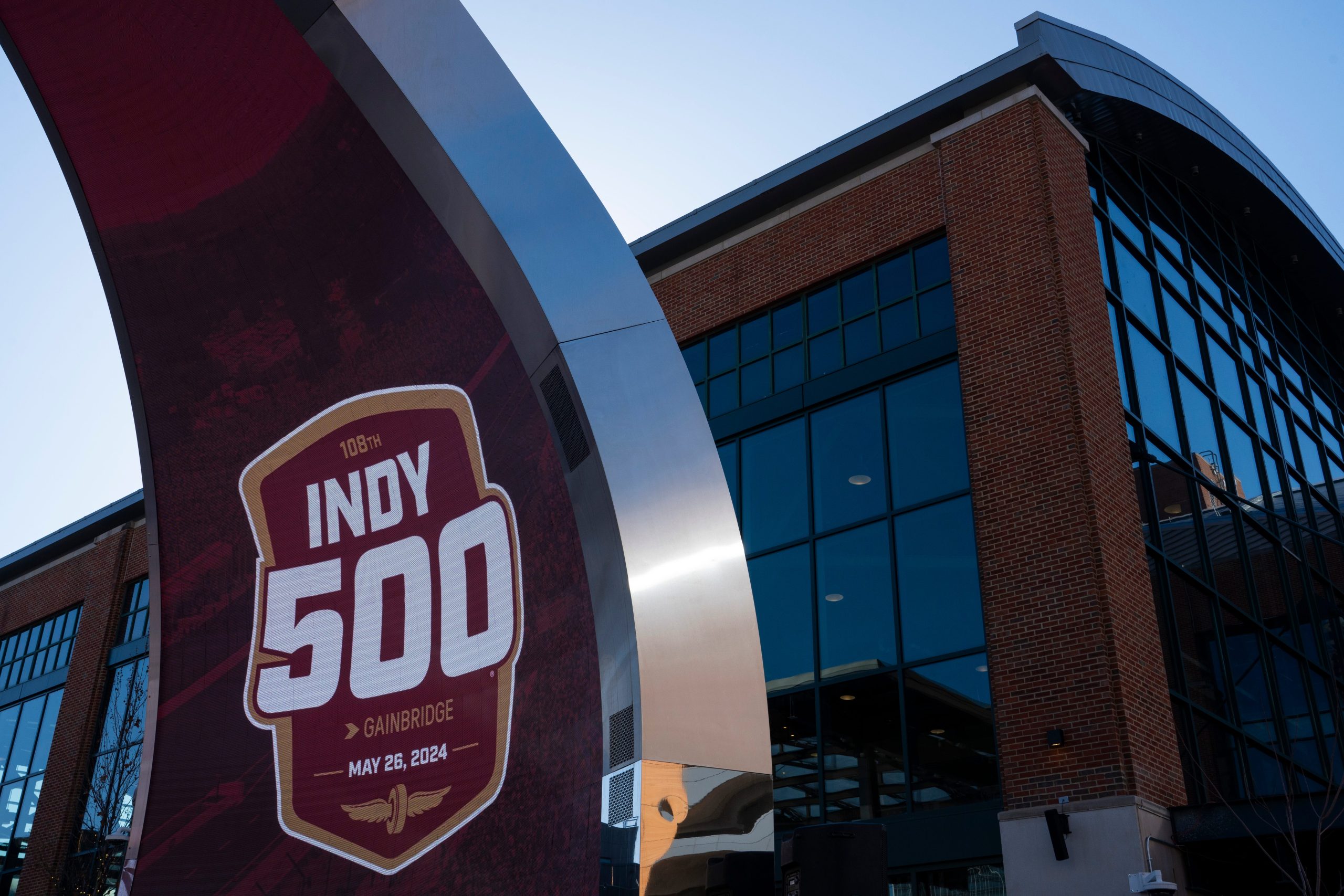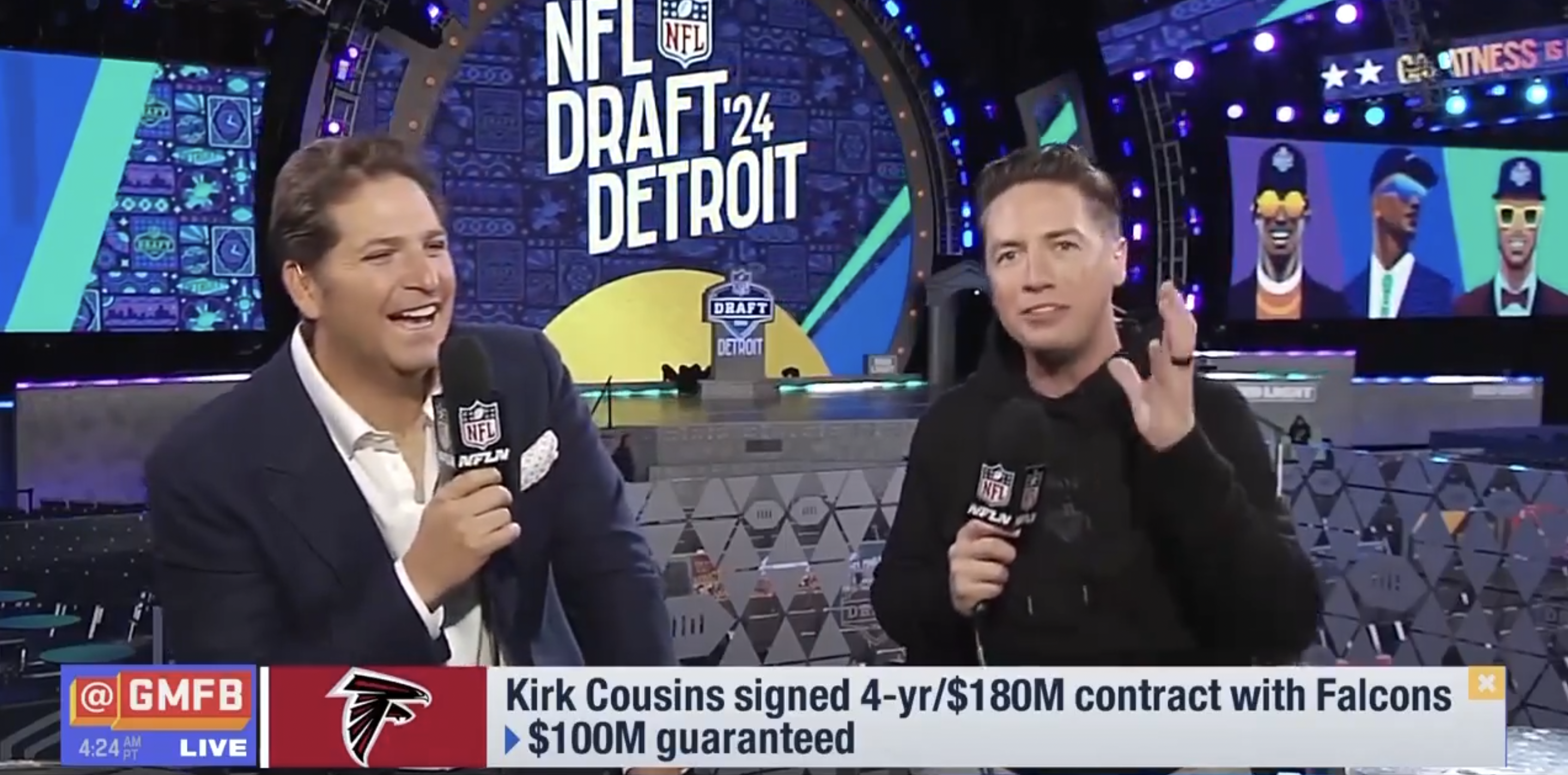The many Fox Sports employees laid off Monday or in the preceding weeks were not surprised. They had witnessed months of maneuvering and strategizing to implement a drastic new direction for Fox Sports Digital and FoxSports.com, and they saw their firings as a natural outcome. What was surprising, though, was the almost-universal sense of relief among those let go, who felt that despite their livelihood being thrown into limbo, at least the sense of uncertainty and dread they’d grown accustomed to was now behind them.
The laid-off employees received confirmation of their fates in an email (found here) from Jamie Horowitz, President of Fox Sports National Networks, that oddly wound up in mailboxes after the publication of a Bloomberg article citing the yet-to-be-sent-out message. (Fox maintains the email was sent before the Bloomberg article published.)
The mass layoffs were the coup de grace of a period that saw Horowitz prioritize the promotion of television programs and personalities over digital content, even enlisting veteran reporters to ghost-write or compose “as told to” content during Super Bowl week for talking heads like Colin Cowherd and Skip Bayless.
Before Monday, there was some hope that the layoffs at Fox Sports Digital would be limited or punted down the road, given that Fox Sports Digital was coming off of its most successful year to date after several years of hemorrhaging money. During the previous week, editors (who have since been laid off) sent an email to the entire editorial team announcing that the contracts of Brett Pollakoff, Caitlin Murray, Cam DaSilva, and Lindsey Foltin would not be renewed beyond the end of the month. Employees were told the decision was based on “the shifting direction of the website” and that “there may be additional changes ahead,” leaving split opinions on whether the cuts were behind them or whether there was a larger announcement to come. As it turned out, the initial layoffs were merely a precursor to a larger wave, which hit Monday, days before the end of Fox’s fiscal year at the end of June.
The following is the inside story of the turbulent last year for Fox Sports Digital, as told by at least 20 current and former Fox Sports employees, all of whom asked to remain anonymous citing ongoing financial entanglements with Fox as well as Horowitz himself. Anonymity was granted as some employees remain under contract and will continue to be paid despite no longer writing for the site although there isn’t any guidance on if they can write elsewhere. Other employees reported their contracts allowed Fox to sever the relationship.
The infamous January presentation
The months of what many coined “uncomfortable dread” can be traced back to mid-January, when Horowitz outlined a dramatic strategy change in a presentation to all digital employees. In September, the digital group had seen another presentation by Horowitz that had outlined the company’s television strategy. Because that meeting had gone over well, the digital team was largely at ease with Horowitz coming in a second time to present his vision for digital editorial operations.
But between September and January, Horowitz had gained control of the digital group, a move that puzzled many observers given that Horowitz’s experience in digital was limited at ESPN to promoting the various shows under his purview. Horowitz was now tasked with bolstering FS1 and FS2’s low ratings while also adding oversight of the digital group, which employed around 100 people at the time.
One of the first changes announced in the January presentation was a restructuring of the product and technology groups to fold into a broader Fox Digital Consumer Group headed by Brian Sullivan. This move, coupled with cuts to the internal ad sales team and a round of editorial layoffs in the months prior, had effectively whittled down the Fox Sports Digital team down to around 50 employees from approximately 150 in 2014 (although many of the product and technology hires remain at the Playa Vista location and still feel they’re part of the Fox Sports Digital group).
But what Horowitz announced next was a jolt that, six months later, still elicits an emotional response from sources who spoke with Awful Announcing. As Horowitz started outlining his digital vision for Fox Sports, he candidly explained that content that had performed well for Fox and was a key part of the site’s turnaround were to be no longer part of the strategy. With a very matter-of-the-fact delivery, Horowitz shared his distaste of the legacy content strategy in place to a room full of employees who had taken great pride in making FoxSports.com a much more trafficked website over the last year (upwards of 50 percent by most accounts).
On viral content say, Horowitz would say:
“Let’s talk about more of what we will be doing less of. Many of you have seen… so this deer runs into the track and field runner and falls down and gets back up. Indisputably, this is excellent video. I’m not here to tell you this is not funny. Please stop laughing. It’s excellent. I laughed, I enjoyed it.
It’s not special to Fox Sports. We put it up, you tell me it got X number of views and that’s great, but you would also note that Bleacher did it, Barstool did it, lots of different places can put it up there. But it’s not special or unique to Fox Sports. And that it makes it hard to make it help define our brand and help monetize it. So we are going to walk away from these types of videos.”
Horowitz would go on to explain that all digital content should center around a handful of key television personalities, regardless of the reader and viewer interest in the content.
“We’re also going to walk away from non-core digital original content. There are some projects we have worked on, again it’s not a value judgement that these are not good, just like the deer, these things were enjoyable, but they don’t belong at Fox. And the Fighter and The Kid was actually doing the worst version of it. They were actually using our brand to build up their brand. And really what we want is to lean into the people that are already part of the Fox family. We’re not trying to build outside brands. So we’re going to walk away from this strategy. Instead, we are going to focus on using our A-list talent. This is one of the many good things that has been made, Shannon Sharpe weighing in on the Conor McGregor fight. That’s perfect. We own Shannon all across all platforms and Shannon is weighing in on what was the big story of the week. That’s what we want to do more of.”
Fox Sports Digital had a diverse editorial roster of nearly 50 individuals with a broad range of focus and pedigree. Horowitz’s explanation of their value going forward remains a sensitive subject to everyone we spoke with, particularly as he presented examples of successful articles Fox would no longer have interest in anymore in front of the very group who had produced them.
“The written word is still relevant, but the advertising value of written content, what we call display, is not growing. Our plan is to refresh our editorial strategy to be more in line with our video strategy. So let’s talk about this. What that means is doing less of this: ‘The 15 most unthinkable QB divorces in NFL history ranked.’ There’s nothing wrong with this. It’s just like the deer video. This is good. I might read it. But it’s not core to Fox. It has no brand identity to Fox. Anyone could publish this. So it’s always going to be hard to monetize things like this.
What really does work is when you take things are good like ’11 Coaches Oregon Might Hire’, that might be something someone is interested in the day Helfrich gets fired, and we change to ‘Colin Cowherd’s 11 Coaches.’ We’ve seen this be very successful. You look at Fox News right now, O’Reilly and his take. That’s all it is. And there are many different ways. “Colin, some of our guys and girls want to write stuff.” Sometimes you might ghost-write it for them. Sometimes you might just hear them say things on shows and that can lead you to write a story about stuff they have said. And here’s a good example of something like that. Bradshaw says something interesting about Greg Hardy on a pre-game show, and immediately writing a story about what TB said. Taking our existing content and making that into news.”
This was one of the major indications that FoxSports.com would undergo a seismic shift. Fox essentially told prominent writers their written work will no longer have a place on FoxSports.com, leaving college football reporter Bruce Feldman, for example, to post written updates on his Facebook page. This only added to the dread and paranoia that festered internally on the heels of leadership turnover and the now-infamous presentation to the digital team by Horowitz that foretold these changes months ago.
Ushered in by what some coined a “shadow” digital team away from their Playa Vista, California digital office, FoxSports.com has now rolled out a new redesign that exclusively focuses on the promotion and recycling of key FS1 talent’s television content and has, for all intents and purposes, fully nixed written content. These earlier plans called for writers to be allowed to continue producing content, but only under the byline of key television personalities like Skip Bayless or Colin Cowherd or simply recapping opinions that were started earlier on various FS1 television programs.
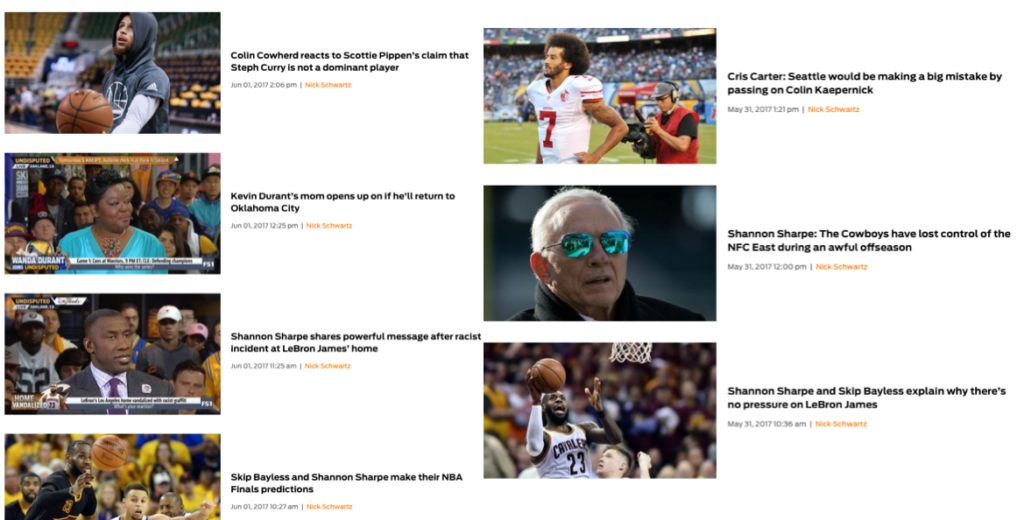
(A look at the page of one writer who was tasked with watching hours of FS1 to churn news out of TV talking points)
The room (and those watching via a stream) were absolutely shocked by the admission that written original content would now have little to no place at Fox Sports and that social news, which was a huge driver of the group’s recent turnaround, was now being signaled out as something to specifically avoid. The reaction from staffers was universal.
“I don’t know how my ears didn’t bleed during the presentation.”
“Everyone who saw the presentation was devastated. Absolutely devastated”
“I knew I didn’t have a job going forward. I just wish he waited closer to the end of people’s contracts or the planned layoffs to tell us we’re all worthless. These last six months have been miserable.”
“He put up examples of content that he said didn’t work for Fox anymore. The writers of that content were IN THE ROOM and a lot of the examples he showed performed quite well. It was more than apparent that Jamie didn’t know what he was doing on the digital side. It was degrading. It was surreal. We were crushed.”
“I don’t think it was done out of malice. When Jamie presents, he thinks he is Don Draper and everyone just thinks he is a genius. He’s not Don Draper, though, and we joke that he’s Donald Trump. He’s totally oblivious.”
“Nobody embraced his vision because it’s fucking stupid. Anybody other than his lackeys can tell you that. Everything we had built and accomplished was getting thrown away for THIS fucking guy?”
When told that employees had expressed misgivings on FS1’s content strategy and the new direction with digital, Horowitz replied with “The philosophy at FS1 and and Fox Sports Digital is to super-serve avid sports fans. That is our philosophy.”
The failed Super Bowl week experiment

The immediate aftermath from the presentation was universal disenfranchisement. Horowitz clearly outlined a vision in which writers were no longer valued unless they were comfortable writing content specifically tied to a television personality’s on-air take or potentially ghost-writing content. But Horowitz hadn’t announced any immediate plans, so there was some hope that legacy leadership in the digital group could talk him off the ledge. That glimmer of optimism evaporated a few weeks later at the Super Bowl.
The previous year’s Super Bowl coverage was a huge success for Fox and with the game airing on Fox in 2017, the digital group was optimistic they’d further their success from the year prior and that Horowitz would warm up to the direction of the digital group. Dieter Kurtenbach and Sam Gardner were two of Fox’s more successful writers and were tasked with covering the game and the week’s festivities. (Both have been informed their services won’t be needed going forward). The two flew to Houston with article concepts in mind for Super Bowl week, but were surprised soon after their arrival when they learned they would now be test subjects in Horowitz’s new content vision.
The pair were summoned to meet with Horowitz and Vice President of Cross-Platform Content Gabe Goodwin, someone Horowitz had worked closely with at ESPN and was believed to be the frontrunner to oversee Horowitz’s digital overhaul. Kurtenbach and Gardner came away from the unexpected meetings with new marching orders and would no longer roam Houston chasing unique stories. Instead, the pair would now be tasked with meeting with FS1 television personalities to absorb their personality, voice, stories, and opinions and craft them into ghost-written articles that wouldn’t appear under their own bylines. Below is a sample of those articles:
Colin Cowherd – The Raiders broke another city’s heart … and have nowhere to go
Skip Bayless – The uncommon trait that drove Tom Brady, Michael Jordan and Barry Bonds to greatness (labeled “as told to Dieter Kurtenbach”)
Skip Bayless – Tony Romo Will End Jerry Jones (labeled “as told to Dieter Kurtenbach”)
Shannon Sharpe – Why I Gave Away My First Super Bowl Ring
Beyond the ghost-writing, Kurtenbach and Gardner largely hung around the sets of the various FS1 shows shooting in Houston that week, wrangling interviews with guests before and after their television appearances, aiming to turn quick soundbites into pieces of written content. The pair churned out a few dozen pieces while in Houston, all of which, according to sources, failed to attract any significant audience. One source called it “a massive failure.”
On the heels of Horowitz’s presentation, morale cratered internally as word leaked out about the impromptu experiment in Houston and the void of compelling content that had just a year ago been a key part of Fox’s digital success during Super Bowl week. (Sources say traffic was down an amazing 50% from the previous year despite the game being on Fox.) Writers were struggling with the reality that a future at Fox would likely mean no longer pursuing stories of their choosing and instead spending significant time dealing with the TV talents’ many handlers. Most interpreted the failed Super Bowl week experiment as confirmation that Horowitz was following through on his presented vision. However, the undeniable failure from the week’s content gave hope to some that management could perhaps find some compromise in establishing a content strategy that was commercially viable and creatively rewarding but also provided the level of promotion Horowitz wanted on the network’s television talent.
Some sources paint another picture around the Super Bowl week experiment, suggesting Horowitz wanted to move to an all-video strategy and that the content vision laid out in his presentation was his attempt to find a middle ground that incorporated written content and continued to employ writers. The failure of that week’s content was proof that a hybrid content approach would not work. Regardless if the content strategy presented by Horowitz was his initial preferred strategy or Horowitz’s attempt at a compromise to continue having some flavor of written content on the site, the lack of success would serve as the datapoint that the strategy was not going to work.
A successful turnaround comes to an unceremonious and undeserved ending
Despite the strong internal skepticism, time will tell if Horowitz’s all-video digital vision will find success. Those with knowledge of the financial picture at Fox Sports Digital shared that the fiscal year ending this week had been a banner year for the digital operation, one that had seen a dramatic turnaround, although this is disputed by some still within Fox.
The disputed newfound momentum and trajectory of the digital business is at the core of many employees’ (past and present) deep-rooted anger toward the changes to the Fox digital strategy, as their understanding was that the business had achieved a significant financial turnaround.
Fox, like many networks not named ESPN, has not only struggled to find an identity online, but also to achieve financial success. For the greater part of the online era, Fox largely functioned like most other networks, delivering a general sports portal strategy with a blend of news, box scores, reporting, and columns. (It should be noted Fox has also been hindered with the lack of success of its fantasy products.) What propped up the website was a traffic deal with MSN, in which Fox was the exclusive provider of content for MSN Sports. This equated to loads of traffic for Fox, to the point that the majority of the site’s traffic came from MSN.
An ad for the website from ~2011
In 2014, the MSN relationship dissolved (a much smaller, non-exclusive relationship replaced it and is still in place), which meant the growing Fox Sports Digital operation would have to fend for itself in terms of traffic. Many view the relationship as short-sighted, having forced Fox to scramble to find a new strategy, identity, and business model once it was dissolved.
This was also Pete Vlastelica’s first full year as EVP of Digital at Fox, and he looked to jumpstart the site’s trajectory after traffic tanked once the crutch of the MSN partnership was removed. (Note: Vlastelica was my boss for a period of time in 2008 at Yardbarker, which Fox would later acquire. He declined to participate in this piece.) It was a bit of trial by fire for Vlastelica, with some experiments paying off while others were unable to find success. Vlastelica was known for having skills spanning a few areas, but he found himself in need of some content veterans to help buoy the site’s newfound reality. Without MSN’s traffic house, the digital operation was hemorrhaging tens of millions of dollars annually, per sources within Fox.
With that in mind, Mark Pesavento was brought in as a SVP of Content Production in mid-2015. Pesavento’s resume includes editorial roles at Yahoo Sports, the LA Times, Sporting News, and most recently USA Today, where he was a critical component in For The Win’s success. Not long after Pesavento’s hiring, Fox doubled down on what some called “For The Win 2.0” strategy and brought in For The Win’s managing editor, Mike Foss, as VP of News Properties. The pair eventually brought over other key personalities from For The Win.
Pesavento and Foss had their work cut out for them and were forced to hit the ground running as the digital operation was facing a lot of scrutiny due to the huge financial losses. Content costs were too high and monetization performance for the site was known by many to be abysmal. The pair caused a bit of a stir initially, slimming down the editorial operation with a significant round of layoffs. With content costs down and traffic growing, and Fox Sports mirroring the social news strategy that had been successful at FTW, the economics of the business were improving. But ad sales continued to be a major pain-point, with Fox bringing in only a fraction of what other comparable sites were making, according to some sources.
Fox took additional steps to increase the website’s attractiveness to advertisers, such as moving Clay Travis’s popular but controversial Outkick The Coverage blog off the FoxSports.com URL and coming to a mutual understanding with Jason Whitlock that his content would not go up on the site. (Fox would launch a site for Whitlock, which has since gone dormant. He now writes occasionally for the Wall Street Journal).
Despite these changes and the lift in traffic, the site continued to underperform financially, as surprisingly low advertising rates continued to bog down the site’s earnings. According to sources, the Fox ad sales team was less than enthusiastic about selling the website to advertisers, and their feedback played a large role in the recent changes. Many tie the strategic overhaul to former YouTube executive Chara-Lynn Aguiar, given her background in video monetization and her reported influence within Fox. Some termed her role as “Horowitz’s Chief of Staff.”
Relief came in the fall of 2016 when Fox reached a partnership with Sports Illustrated in which SI took over ad sales for Fox with guaranteed rates on Fox’s ad inventory. Essentially, “SI didn’t have enough traffic for all the ads they were selling, so we buddied up,” as one source described the arrangement.
The deal was a game-changer for Fox, and the site almost immediately became reliably profitable. The structure of the deal also saw traffic targets outlined, serving as a unifying and motivating goal for the team who rallied to increase traffic to new heights so that Fox could unlock all possible revenue from the lucrative partnership. While accounts of the financial picture at Fox Sports Digital vary, most paint the same picture of a turnaround from 2014 up through now that saw the business go from losing tens of millions dollars a year to being profitable. And by some accounts, the turnaround was trending towards eight figures of profit. The newfound profitability, management, and site growth buoyed internal morale, which had faced a few years of uncertainty following the dissolution of the MSN partnership and the 2016 layoffs.
Fox Sports disputed the assertion that Digital was profitable and that people’s anger towards management was tainted by faulty financial insights. However, sources with knowledge of the financials at Fox Sports Digital adamantly push back against any characterization that the group had not become profitable.
Editor’s Note: Part of the discrepancy can be attributed to the accounting of revenue from Fox Sports Go, which is absorbed by the digital group but has some of its expenses covered by another group. Another issue is that Fox Sports Digital is saddled with a bad real estate deal in which Fox leased an entire campus believing it would house Scout, MySpace, and Fox Sports Digital. The digital group has had that financial baggage tied to it.
We’re told FS1 does not have the cost of their studio locations tied to their financials, so that puts the digital group at a disadvantage when comparing apples to apples. With that said, the editorial budget was believed to be $2.5 to 3 million dollars and the reported revenue from the SI deal multiples higher than that amount. The most common financial numbers we heard were that Digital’s expenses were roughly $50 million this past year and will show a profit (at least on paper) of around $10 million. But again, this is all disputed by Fox.
Horowitz’s digital takeover begins
Launched with the notion that it could compete with ESPN, FS1 had struggled mightily after nearly two years to attract an audience outside of airing live events. In April 2015, Horowitz was brought in to oversee “all programming, marketing and scheduling for Fox Sports 1 and Fox Sports 2,” where it was assumed he’d bring his flavor of loud, personality-driven, opinion-based content.
Horowitz’s first year centered around bringing in familiar faces over from ESPN on both sides of the camera, while also winding down programs that predated his involvement. A year-plus into the job, Horowitz began to turn his eye towards digital. Details remain sparse as to Horowitz’s motivation for taking control of the digital operation considering his lack of familiarity with the space, but one staffer provided this theory:
“More and more content was being produced and consumed online for and on social platforms. I think Jamie didn’t like the idea he wasn’t in control of that budget and it wasn’t reinforcing or doubling down on what he was doing on FS1. If that stuff did well and his shows struggled, how would that look? He wanted the budget all under his control.”
Given the turnaround effort the digital group was beginning to achieve, Vlasetlica dug in as Horowitz began to lean more on the digital operation to better align strategically with the TV strategy. Accounts vary on whose idea it was for Horowitz to gain oversight over digital, but multiple sources conveyed that Vlastelica was firm in not serving under Horowitz if there was any type of corporate reorganization, something that seemed to be in motion. As one former employee explained:
“The pair didn’t get along. It was very clear to us and whether Pete technically left on his own or was forced out is irrelevant. Jamie made it uncomfortable for him to work there and Pete said “I don’t need this shit” and found a better job. It was the smart thing to do.”
Vlastelica would go on to take the CEO role at Major League Gaming, Activision Blizzard’s eSports division, in October and then ceded control of digital to Horowitz after a brief interim period in which digital was run by Devin Poolman. However, the transition wasn’t seamless. The conflict between the two was hard to ignore. Here’s how Vlastelica, with one foot out the door, introduced Horowitz before one of his well-known “vision” presentations, in which he bashed ESPN, SportsCenter, and Disney while touting personality-driven debate programs:
“Jamie wanted to come down and introduce himself first of all, and then present a vision document. I’ve seen this… how many times have I seen this now? 11? I think it’s been more than that. I’ve seen it so many times that I resigned so that I wouldn’t have to see it again, but here we are. One more time.”
With FS1’s focus on “owning the fall” (where the bulk of their live-event programming takes place), Horowitz largely centered his attention on television, allowing the digital operation to operate normally throughout the fall. However, Horowitz was becoming noticeably more interested in learning more about the operation. Throughout the winter and into the spring, Horowitz summoned various people within the digital operation over to the Fox lot to get up to speed on the strategy in place and the industry as a whole.
“It mirrored Donald Trump trying to learn about health care reform”
Along with Horowitz’s infamous January presentation, the meetings further solidified the viewpoint that Horowitz was going to drastically unravel the digital operation. Meetings with Horowitz were known to be “trying,” and were routinely discussed among the staff, as described by multiple sources.
“The joke with many of us is that it mirrored Donald Trump trying to learn about health care reform, but having the same minimal knowledge and attention span for it.”
“If it wasn’t an idea of his, he didn’t care. If it didn’t involve someone on television, he didn’t like it or care. He didn’t like anything we did, regardless if it was successful.”
“He kept asking about various initiatives and things we did. He’d ask why? Why everything? You’d explain because it’s popular. It makes money. It’s growing. He just didn’t care. Because it wasn’t his idea.”
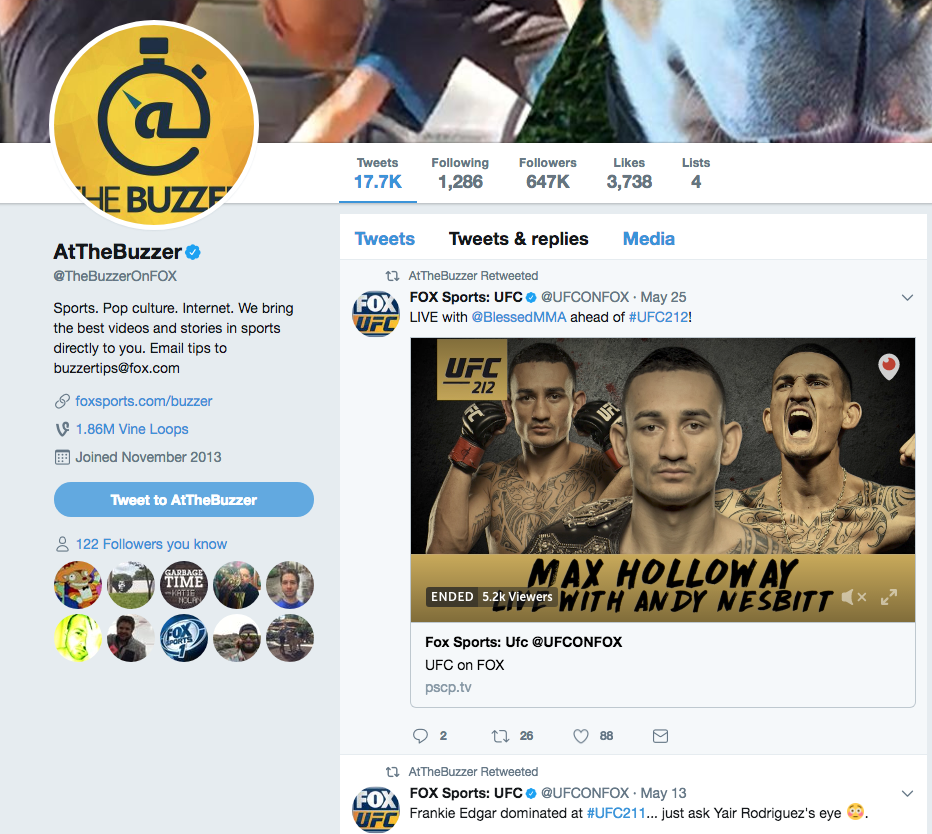
Podcasts like The Fighter and The Kid were wound down abruptly. Partnership talks with companies like Snapchat didn’t move forward. A good example of Horowitz’s distaste to any initiative predating his tenure can be found with Fox’s popular At The Buzzer Twitter account, which amassed nearly 650,000 followers but has been dormant since mid-May. The winding down of these Fox Sports Digital tentpoles follows a similar playbook to what Horowitz did with FS1’s programming, in that all brands that predated his hiring were put out to pasture. One source described the enmity over all that work gone for naught.
“The thing that pisses me off is that Fox Sports and Fox Sports Digital had good cultures and good people. Lot of people that fit in well, were loyal to Fox, and did great work. These people were seen as reliable and with a lot of upside going forward professionally. We were excited about disrupting ESPN. A lot of those people are gone now spanning the whole company and there is only one reason and it’s that you’re walking around with a target on your back if you’re a higher-up that was here before Jamie took over regardless of what you’ve accomplished, how much you’re liked, and what protection you thought you had. I’ve seen people bring in their own people before, but this is something totally different.”
Fox firmly disputes this characterization and conveyed that any brands or people who have been let go were just not working out for the company or fitting in with new strategies.
The beginning of the end
There was some hope internally that Horowitz could be talked out of a dramatic strategy overhaul. The Super Bowl experiment had failed, the SI partnership was too good to pass up and would be difficult to back out of. More importantly, many inside Fox were lobbying Horowitz to give pause, considering his unfamiliarity with the digital space.
That fleeting hope evaporated in early May when Fox tabbed Alexis Ginas as Senior Vice President, Cross-Platform Solutions. Many had hoped Pesavento or Foss could potentially find some middle-ground strategy to appease Horowitz, but the hiring of Ginas extinguished that optimism. Ginas had no experience in sports and little in editorial content. Her previous position was focused on monetizing Tinder with brand solutions. The hiring was seen by multiple sources as the beginning of the end for their time at Fox.
“That’s when I started sending out my resume. A non-sports person from fucking Tinder? In what world does that make sense?”
“I didn’t think Mark or Mike would get promoted by Jamie, but even I couldn’t believe who they ended up going with. Selling beer ads on Tinder doesn’t qualify you to run a sports site.”
Fox pushes back on this assertion by saying Ginas’ role is centered around monetization and other executive roles that have recently been filled are focused on actual content.
While Ginas has yet to make an impression either way, many questioned how her hire could have been approved. Some theories hold that Horowitz contractually holds specific hiring abilities and other executive powers that he may have insisted upon, given how he very publicly flamed out at NBC before his start date. While some former employees hypothesized that Horowitz’s mandate superseded Fox Sports President Eric Shanks, former senior Fox executives on the television side discount that theory and assert that it was indeed Shanks’ idea to hire Horowitz. Shanks wanted to wash his hands from running the network when he realized there was little hope for FS1 to compete with ESPN and a dramatic cutting of costs would have to take place.
The fallout from the executive shakeup didn’t take long, as Pesavento announced he was leaving shortly after Ginas’ hiring was announced.
I believe strongly in digital. And I also get the culture of fear that comes with declining ratings and cord-cutting. It’s a vicious circle.
— Mark Pesavento (@markpesavento) May 18, 2017
A few weeks later, Foss announced his departure.
https://twitter.com/themikefoss/status/873337482166681600
FoxSports.com becomes video only
The new FoxSports.com without written content was a closely guarded secret until its unveiling Monday. According to sources, the impressive rollout with the video-only site was achieved via a separate digital operation on the TV lot away from the Fox Sports Digital office in Playa Vista.
Details of this team are murky, but we know it focused on promoting FS1 television shows and was led by Gabe Goodwin, who may now actually depart the network. Sources say Ginas’ hiring and the added layer of management between him and Horowitz may have soured Goodwin’s interest in staying with the network. Horowitz specifically brought Goodwin over from ESPN after a brief stint producing Garbage Time for Embassy Row, which allowed his non-compete from ESPN to expire.
Heading content initiatives going forward will be former ESPNer Mike Bucklin, who served as a Coordinating Producer the last year and has now been elevated to a Vice President. Many were skeptical of the promotion given Bucklin’s focus on what was described as “mainly controlling the Undisputed Twitter account.” Despite that initial skepticism, many believed he was making a good faith effort to get a full lay of the land before deciding where and how deep the pending cuts would go. The extent of the cuts suggests that may have not been the case.
A bitter pill to swallow
I searched for a contrarian opinion on Fox’s new digital direction, but sources at Fox Sports Digital were adamant that Horowitz’s preferred strategy would fail in spectacular fashion. Some envision that the company may exit their lease ahead of schedule, which seems to be plausible given the extent of the cuts. Whatever the outcome, employees were not shy in sharing how they felt about Horowitz’s power play for Fox Sports Digital.
“I understand management has the right to make big changes, but this is installing people who don’t know what they’re doing at all, nor really seem to care that much. When has that ever worked?”
“I’ve been through layoffs at a lot of places. Usually it’s because you’re losing money and aren’t growing. That’s what makes this a bitter pill to swallow. We don’t deserve this. We don’t deserve to be treated like this.
“There is no way any of this works. The TV strategy or the digital strategy. They’re doomed and we’re now either going to have to scramble to stay afloat elsewhere or do the soulless drivel Jamie wants us to do. I try not to think about it, because the whole thing makes me livid.”
“This is all driven by ego. Jamie’s huge ego. He’s not only ruining Fox’s reputation on television, but he’s spreading it like cancer to digital. They’ll can his ass when they realize the emperor has no clothes and he’ll find another place to ruin.”
But one former executive on the TV side was firm that while digital could fail, the company was invested in Horowitz’s television strategy long-term—beyond his current contract, which we’re told ends in the summer of 2018.
“Ratings are up and costs are down. That’s what he promised and you’re right that a lot of people have made a negative connotation about the FS1 brand. The brand is already tarnished but people are still going to watch games regardless what they think of the studio shows. Fox Sports like the NFL, MLB, and NASCAR coverage hasn’t embraced FS1 and as long as the Fox Sports brand doesn’t get dinged much, they’re okay letting Jamie do his thing on FS1 and hoping it can squeeze out some profit there. They figured out they can’t compete with ESPN and so bringing on Jamie was their way of stepping away from that impossible endeavor and also cutting costs and it’s worked.”
Fox denies that any of the changes to digital are motivated by any personal agenda, saying the changes are just the reality of the business they inherited. They say that, essentially, the drastic shift was needed and Horowitz’s infamous presentation represented an upfront and honest leadership approach based on the reality of the situation.
Horowitz’s content strategy for FS1, as well as digital, could find success. But for those involved, the jobs lost and months of low morale are hard to justify regardless of the outcome. One employee went as far as saying some employees suffered from health problems stemming from the stress of the uncertainty from the January presentation.
FS1 launched nearly four years ago with the promise of being a fun competitor to ESPN. Four years in, outside of live games, the network has failed to compete with ESPN, and few could argue the light-hearted fun marketed to sports fans early on is displayed on the network or within the corporate culture. For many inside Fox Sports, the violent whirlwind of change has been both eye-opening and dispiriting. On the heels of layoffs at other media companies, many are preparing to move onto other careers, such as PR or teaching.
“I used to say I would never work in PR or some other corporate bullshit, but after this, I don’t think there is a level of corporate bullshit that would even come close to what we’ve had to deal with this past year. It’s a nightmare and I’m ready for it to be over.”
On Monday, the “nightmare” did, in fact, end, leading to an overwhelming sentiment of great relief that it was now over. Now that’s been replaced by the question of where, if anywhere, the laid off employees could go to continue working in sports media.

